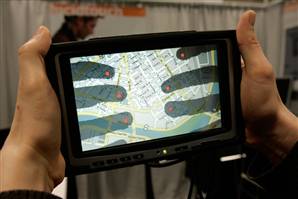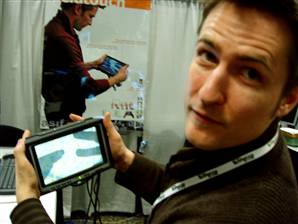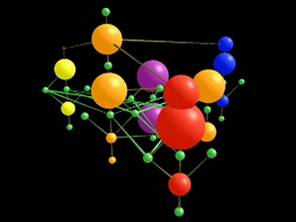Posted: Tuesday, March 04, 2008 8:35 PM by Alan Boyle
 Microsoft via AFP - Getty Images Microsoft via AFP - Getty Images |
Microsoft's LucidTouch displays "pseudo-transparent"
fingers on a handheld computer screen. Sensors
keep track of your fingers on the back of the device.
|
Once a year, Microsoft Research gives
outsiders a glimpse of its high-tech frontiers: gizmos that transform
your fingers into ghostly digits on the screen, or make you look like a
Webcam celebrity ... viewers that let you unravel the inner workings of
the cell, or explore the outer depths of the cosmos ... sensor networks
that monitor how climate change affects glaciers in the Swiss Alps, or
how the chemistry of life works at the bottom of the Pacific Ocean.
Even though I work right on Microsoft's main
campus, I'm usually counted as one of those outsiders - but today, I
finally got my first glimpse at TechFest, a science fair geared for grown-ups.
Microsoft Research TechFest has been around for seven years, but
until last year it was meant exclusively for the software company's
employees. It's actually a cross between a science fair and a trade
fair, with researchers showing their innovations to product developers
who might actually use them.
Last year, the company opened up the TechFest displays for one day
to potential customers and partners, as well as journalists and
dignitaries. The same system was in effect this year.
Microsoft may be a partner (along with NBC Universal) in
the msnbc.com joint venture, but we're treated pretty much like other
journalists when it comes to press access. So, armed with my press
pass, I walked over to Building 33 on the Redmond campus this morning,
waltzed in the door and blended in with the crowd - which included
representatives from NASA, the Pentagon's Defense Advanced Research
Projects Agency and a host of universities.
Clearer view of virtual telescope
The headliner at the event was the WorldWide Telescope, an astronomy program that we first wrote about last week (when it was demonstrated at the TED conference).
Today, researchers at Microsoft and beyond were more willing
to talk up-front about the virtual telescope, which is expected to
go into free public release late this spring.
Like Google Sky, Stellarium
and other such programs, WorldWide Telescope blends astronomical
imagery from multiple sources using a clickable, zoomable interface
that simulates the night sky on your desktop. Microsoft Research's
Curtis Wong said he hoped the program would make its mark by letting
astronomers and the general public create their own virtual tours of
cosmic wonders.
"If you can create a PowerPoint presentation, you can create a guided tour of the sky," Wong told me.
One of the presentations demonstrated today was created by
a 6-year-old Toronto boy named Benjamin, who gave a charming tour of
the Ring Nebula. "My dream for this is to have more and more of these
stories," Wong said.
But the WorldWide Telescope is more than a child's plaything:
Professional astronomers are already planning to use it to archive
data, present their observations in an academic setting, and even open
the way for analysis and discovery.
"The astronomy community is really excited about it, mainly because
we paid attention to a lot of details they care about," Wong said.
One of the early adopters is Alyssa Goodman of the Harvard-Smithsonian Center for Astrophysics.
"What we're doing is adding the functionality that only
professionals would care about," she told me in a phone interview.
"Making tours of papers, for example, or being able to do things with
the coordinate system. ... The important thing is that it will become
probably the premier interface for the professional virtual
observatory."
The other sky software packages have their pluses as well, she said
- and competition is usually a good thing for everyone involved.
"The way I see this is, it's almost like the browser wars," Goodman
said. "The content is already out there, and right now I see this as a
browser for the sky. ... The dream of the whole virtual observatory
community is that all of these tools will interoperate as well as the
Web does."
The technology behind the WorldWide Telescope could spawn other products as well.
"Some of the things we're able to do there may be brought into the
medical sphere," Craig Mundie, Microsoft's chief research and
strategy officer, said at TechFest. He pointed out that once you have
the mechanism for blending terabytes of data from multiple
sources, you could use that mechanism to present astronomical
imagery from radar scans and X-ray telescopes ... or medical
imagery from PET scans and hospital X-rays.
The WorldWide Telescope wasn't the only virtual realm on display. Here's a quick rundown on some of TechFest's other wares:
Virtual fingers
The coolest gizmo I saw was a handheld mobile device tricked out with a technology called LucidTouch, which allows you to work a touchscreen by moving your fingers on the back
of the device. A ghostly, semitransparent projection of your fingers
appears on the screen itself, thanks to a Webcam and a touch-sensitive
surface on the back side.

Alan Boyle / msnbc.com |
Microsoft Research's Patrick Baudisch demonstrates
the LucidTouch device at TechFest.
|
Microsoft Research's Patrick Baudisch
developed the technology to do away with the frustration of having to
put your big fat fingers on a small touchscreen. The
"pseudo-transparent" fingers are overlaid on touchscreen controls and
give you an eerily effective sense of feedback as you twiddle your
phantom digits.
Eventually, Baudisch hopes to do away with the
clunky Webcam sticking out from the back of the device and get the
technology built into a wide range of small-screen devices, ranging
from smartphone-style wristwatches to handheld game consoles.
"Using the same surface twice isn't a great idea," Baudisch
explained. "So why don't we use the surface that hasn't been used: the
back."
Virtual cells
Andrew Phillips and his colleagues
at Microsoft Research's British facility have developed a visual
programming language, known as the Stochastic Pi Machine
or SPiM, to help biology researchers analyze how cells do their work.
The program can take a tangled chemical pathway and figure out what
quantities of which proteins should be produced by that pathway.

Microsoft Research / msnbc.com |
Click for video: Msnbc.com's Alan Boyle narrates
animations from Microsoft Research that represent
cellular signaling pathways at work.
|
"We want to build a model of a biological
system on a computer," Phillips said. "We take a very complicated
network and break it up into more manageable parts."
Graphic representations of
chemical reactions in the cell show proteins as colored balls of
various sizes, growing and shrinking as they are built up and broken
down. The green connecting lines represent signaling pathways.
Researchers can compare the predicted outcome
of a biological process with the actual results of their experiment, to
find out if their model for the process is correct. Someday, the
simulations might even suggest new strategies for
countering cancer or developing new drugs.
Sensors on the ocean floor
Microsoft is
participating along with the University of Washington and the Monterey
Bay Aquarium in a program called Trident, which is developing a sensor
system for studying the Pacific Ocean's active
seafloor. Trident meshes with wider efforts known
as Project Neptune and the Ocean Observatories Initiative.
Eventually, scientists could be watching the ocean floor
remotely with HDTV cameras, seismometers, sonar and other scientific
instruments - with all the data flowing back to land via a fiber-optic
network.
"Once you have thousands of sensors, how do you process all that
data?" said University of Washington oceanographer Deborah Kelley,
a member of the Neptune team.
That's where Microsoft is helping out, by devising the data
flow management system that will let researchers hundreds of miles from
shore interact in real time with their experiments. "It
democratizes science," Microsoft Research's Roger Barga explained.
Sensors on mountaintops
Another sensor-based scientific project is called SenseWeb. Swiss researchers are using SenseWeb to knit together data from weather monitoring stations planted in Switzerland's Genepi rocky glacier.
A software program called SensorMap can extrapolate from the
individual wind and temperature readings to develop time-lapse maps of
the entire area. SensorMap also could be used to keep track of
Seattle-area traffic or San Francisco airport parking, as shown on the project Web site.
Lights, Webcam, action!
One of the
not-yet-ready-for-prime-time technologies we saw demonstrated was a
little something called "Active Lighting." It's basically two
low-power LED arrays that are set up on each side of a Webcam-equipped
computer monitor. When you turn on the video, a computer
program checks your image and starts switching different-colored
lights on and off.
"It analyzes the video and adjusts the lighting so it looks nice," Microsoft Research's Zhengyou Zhang explained.
How does the computer know when your image looks the nicest? Zhang
said the software compares the lighting on your face against a database
of celebrity photos. The more you look like a celebrity, the better the
lighting must be. And who can argue with that?
For more about TechFest, check out these reports from CNet, Computerworld, Gizmodo, InfoWorld, Wired and Microsoft's TechFest Live blog.


